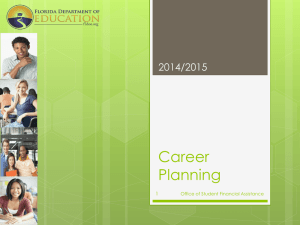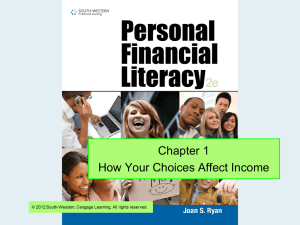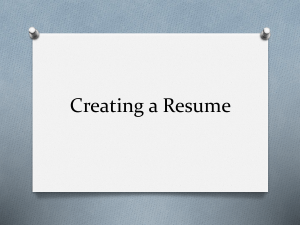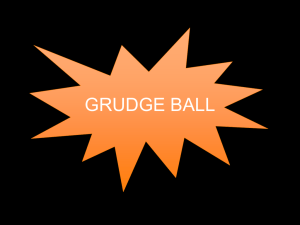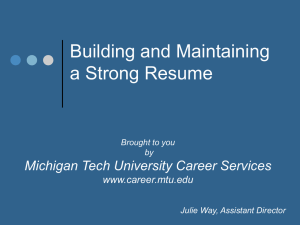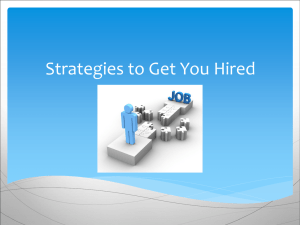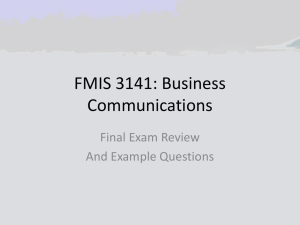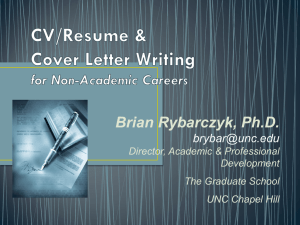Workshop Presentation (Week I)
advertisement
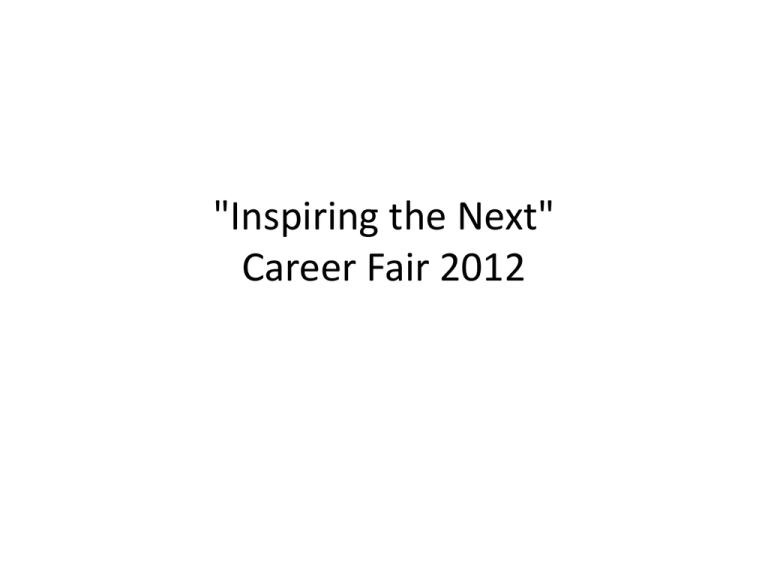
"Inspiring the Next" Career Fair 2012 CV & Self Preparation for an Interview • • • • • • • • Vision Mission Objectives Self Development Recruitment Preparing your Resume Facing an Interview Work Habits Vision the vision statement answers the question, “Where do we want to go? it's the vision statement that provides the destination for the journey, and without a destination, you cannot plan the route Ex:• To be the foremost appliance retailer in Asia pacific • Obtain my Masters Degree by year ….. • Build and complete my house by year …. Mission • A personal mission statement provides clarity and gives you a sense of purpose. It defines who you are and how you will live. Goals /Objectives Setting Specific Goals A specific goal is an incorporation of an action plan that outlines how you will achieve the goal, and a performance measure that tells you how you will evaluate the goal. Self Development • • • • • Education Communication IT knowledge Business Etiquette Leadership skills WHAT IS RECRUITMENT? • Recruitment is attracting individuals timely in sufficient numbers, with appropriate qualifications, and encouraging them to apply for jobs in an organization. Attracting people for a job At the right time The right person Encouraging them to apply RECRUITMENT PROCEDURE • • • • • • • • • • • • Employee Requisition Form Advertising Application Scanning Written test Evaluation of written communication and analytical skills Preliminary interview. Selection from the Final interview Personnel reference Checks Background Investigation Medical Test Issuing Appointment letter Induction How to prepare your Resume The purpose Identify what is important to focus on when preparing yours Resume. • A resume is an overview of your experience and credentials put together to sell your self • It is an introduction of yourself to the employer • A good resume will be easy to read, positive, and interesting. • A resume is not a summary of what you have done • It should be focused on the job targeted, and the content relevant • Don’t develop a "one-size-fits-all" resume without tailoring it to the specifics of the job • • • • Look at examples Books Go on line Know what the reader will be looking to get out of a resume. Behaviors that a reader will want to see in your resume • • • • • • • • • • • communication and listening skills, ability to be a team player, goal orientation, analytical skills, motivation and initiative, reliability and dedication, determination, confidence, pride and integrity, efficiency, ability to follow directions Things to remember • Make it easy to read • Recruiters approach resumes conservatively • Do not print resumes in color paper, in 3D, with unusual fonts, • Don’t include products the company's trying to sell. • Stay with what is tried and trusted • recruiters like the familiar standard formats. • • • • Use the font size 10-12. For a traditional look Use the Times New Roman or Arial Non-traditional fonts will look unprofessional When emailing them, your employer may not have the font type, your resume will end up unformatted • You can avoid this problem by emailing the document in PDF format. • Avoid switching between too many fonts. • Use bold and italics to make important information stand out but use bold sparingly. • Also make use of white space, ensure there is enough to make it easier to read. • Use black and white. Color should be used restrictively and preferably not at all. • Keep the format neat and well organized consistently • If printing hard copies, use quality paper. • maintain the correct tense and grammar throughout the resume. Decide on the positioning of the content. • A resume can be chronological (placed in date order) or functional (focused on specific professional skills). • The chronological resume is the more common, • Chronological resumes work well for people who have remained in the same profession and can demonstrate an evolving, improving history of experience. • For people who change jobs frequently, it can make you appear less reliable and knowledgeable. • The functional resume works best for frequent job changers, • Many resumes tend to be a combination of both approaches now. Make a master list. • This list will be your background working document from which you create each new resume. • Education • Experience • Extra curricular activities • Positions held • Licenses and accreditations Consider the resume content carefully • A resume should be brief. 1 to 2 pages in length at the most. • The standard is a page for every 10 years of experience is appropriate. • On average, a resume is given less than two minutes reading time, • Interview is the right place to share more information. • List your scholastic accomplishments, official positions, student council memberships, awards, etc. • Provide your educational history. • Always list top accomplishments first, PhD, MA, BA, diploma, certificate. • List relevant scholarships and awards. • Include Job positions that were extensive. • Include accreditation and licenses. • Include employment dates. (important) • Include an address, phone number, and email address. Don't use your current employer's name, number or email, • You may list references by names, because it's assumed by the recruiter that you have references. Tailor your resume • Using your master list as a prompt, craft a resume targeted at your intended job. • Use the job advertisement, job description, media information, internet, newspaper, company's own press releases, speak to anyone you know who works in the place, etc • list your experience in terms of accomplishments and achievements rather than tasks and responsibilities. • For example, "Cut expenses by 25 percent over six months. • Accomplishments that can be quantified can be helpful • Explain the relevance to the targeted job of the content placed in the resume. Know what to watch out for • Don't make demands. • Don't inflate your achievements , qualifications and abilities. • Don't over-qualify yourself for the position. • Be careful not to be stubborn, arrogant, or difficult to work with. • Avoid listing weaknesses. • You may mention the age, race, religion, gender, and national origin. • Forget the photo - The current trend is moving away from the inclusion of a photo • Avoid wasting space such as telling the employer you're available Proofread and revise • • • • • • • • Proofread your resume several times. Check for spelling errors and grammatical errors Examples 01 Example 07 Examples 02 Examples 03 Examples 04 Examples 05 Examples 06 The Interview • • • • Greeting Asking your name Introduction of the panel Brief introduction of your self your family – parents, brothers & sisters where you studied what you did at school -sports/drama etc. info on OL & AL results • What you did after leaving school • Your professional education and experience in working • What you do now, work and education • Explain further about your education or your experience in a specific subject or area • If studying what are the time periods of the week • Willingness to work away from home • Willingness to work late • Marital status, newly married or not • Whether you like to start from the ground • Whether you like work in a different field out of your education area • Whether you like to travel in your job • Whether you like to work in in outstations • Whether you like to work under a junior boss • Whether you like to work in estates • Warehouses, walking salesmen, at sales assistants etc. • • • • The way you answer will judge your attitude Commitment Honesty Willingness • The interviewer will seek for good work habits of the applicant in various ways. Indicators of Good Work Habits 1. Reliability 1. Accuracy 2. Good record keeping 3. Good follow up 4. Punctuality 5. Regularity 2. Responsiveness This means Willingness of the employee to provide the service 1. Duty before self 2. Extra effort 3. Prompt service Competence This means having required skills and knowledge to perform the job 1. Knowledge 2. Skills 3. Attitudes 4. Courtesy 1. Politeness 2. Respect towards others 3. Consideration 4. Listening 5. Greeting 6. Cheerfulness 7. Professionalism 5. Communication 1. Keeping your manager informed 2. Giving and receiving information feedback 3. Take time to explain 4. Active listening 5. Avoid making assumptions 6. Overcoming barriers to communication 6. Credibility 1. Trust-worthiness 2. Honesty of purpose 3. Doing what you say (promise) 4. Personal qualities 5. Correct relationships 6. Openness 7. Empathy 1. Knowing and feeling the needs of the customers both external and internal 2. Ability to understand without being told! 3. Learning about specific needs 4. Anticipation of needs 5. Giving personal attention 6. Make others feel they are welcome Recap • • • • • • • • Vision Mission Objectives Self Development Recruitment Preparing your Resume Facing an Interview Work Habits Thank You
